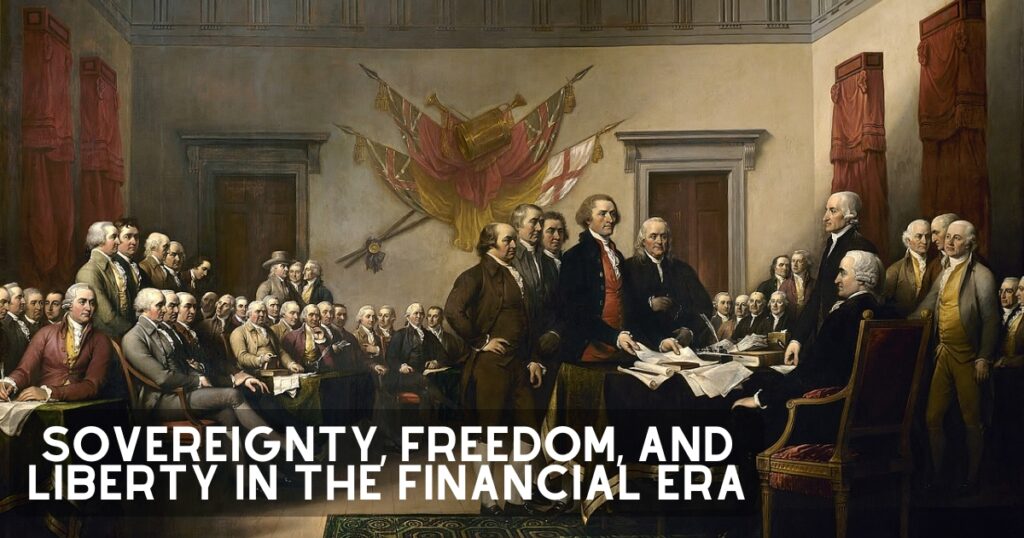Sovereignty, Freedom, and Liberty in the Financial Era: A Call for a U.S. Sovereign Stablecoin
For centuries, the concepts of sovereignty, freedom, and liberty have shaped humanity’s greatest ambitions and struggles. These are not merely abstract ideals—they are the foundations of individual rights and collective progress. However, as the world evolves, these principles must be reimagined and defended, particularly in the realm of finance, where centralized control often undermines personal autonomy.
What Is Sovereignty in Finance?
To appreciate the importance of financial sovereignty, we must first define it. Sovereignty is the authority to govern oneself or one’s resources without external interference. On an individual level, it empowers people to make independent decisions. On a national level, it represents a country’s ability to regulate its resources and policies free from foreign dependence or domination.
A striking example of national sovereignty is the sovereign wealth fund (SWF)—state-owned investment funds sourced from national reserves. Often funded by natural resource revenues, SWFs preserve wealth for future generations, exemplifying financial autonomy and responsible management. In today’s decentralized economy, similar principles of stewardship can be extended to individuals through cryptocurrency.
Cryptocurrency: The Key to Personal Financial Sovereignty
Cryptocurrency has emerged as a revolutionary tool for personal sovereignty in finance. Visionaries like Robert Breedlove emphasize the deep connection between currency and freedom. As Breedlove aptly puts it, “Money is the ultimate nexus of trust and value.” Cryptocurrencies eliminate dependency on traditional banking systems, which are prone to corruption, coercion, and failure.
Similarly, Satoshi Nakamoto, the enigmatic creator of Bitcoin, highlights the importance of reducing trust-based dependencies in financial systems. In the Bitcoin whitepaper, Nakamoto stated, “The root problem with conventional currency is all the trust that’s required to make it work…the history of fiat currencies is full of breaches of that trust.” Cryptocurrencies empower individuals to reclaim control over their wealth by decentralizing financial systems.
The Next Evolution: Sovereign Stablecoins
A groundbreaking step forward in this movement is the development of a sovereign stablecoin. Unlike traditional cryptocurrencies, stablecoins are pegged to stable assets like fiat currencies or commodities, offering low volatility alongside the decentralized advantages of crypto. A sovereign stablecoin could serve as a game-changing instrument for both nations and individuals by:
- Preserving Purchasing Power: Protecting economies from inflation and financial instability.
- Enabling Global Participation: Providing individuals access to a decentralized financial network free from centralized control.
Why the U.S. Needs a Sovereign Stablecoin Backed by Fiat Currency
The creation of a U.S.-sovereign stablecoin—pegged to the U.S. dollar—has the potential to transform the financial landscape, delivering stability, security, and inclusion. Here’s why this innovation matters:
- Stability in Digital Finance: A U.S.-backed stablecoin offers a safe entry point into the volatile cryptocurrency market, enabling Americans to participate in digital finance with confidence. Grounded in the trust and credit of the United States government, this stablecoin would create a reliable digital currency for both domestic and international use.
- Reinforcing the Dollar’s Global Dominance: As the U.S. dollar faces competition on the global stage, a sovereign stablecoin would strengthen its position as the leading global reserve currency. It provides a secure and accessible payment method, ensuring relevance in decentralized financial systems.
- Fostering Financial Inclusion: A U.S. sovereign stablecoin could empower underbanked populations, giving them access to modern financial tools and opportunities for economic advancement.
Regulatory Considerations: IRS Guidelines and Reporting Requirements
When designing a sovereign stablecoin, it is essential to navigate key regulatory frameworks:
- Cash Under $600: All income must be reported to the IRS, but the $600 threshold determines whether a payer issues a 1099 form—not the taxability of income itself.
- $10,000 Bank Transaction Rule: Under the Bank Secrecy Act, financial institutions must report cash transactions exceeding $10,000 to combat money laundering and fraud.
A sovereign stablecoin must balance regulatory compliance with its promise of privacy and autonomy.
Combining Tradition with Innovation
Adopting a U.S.-backed sovereign stablecoin bridges the gap between the reliability of fiat currency and the innovation of blockchain. It ensures that the United States continues to lead the global economy by combining:
- Technological Advancement: Embracing cutting-edge blockchain solutions.
- Economic Security: Ensuring stable, trustworthy financial tools for all citizens.
- Global Influence: Strengthening the U.S. dollar’s role in a decentralized world.
The Argument for Sovereignty, Freedom, and Liberty in Finance
The introduction of a sovereign stablecoin perfectly aligns with the ideals of sovereignty, freedom, and liberty—values deeply rooted in the American ethos. By empowering individuals and nations, stablecoins pave the way for a resilient, independent, and equitable financial future.
The time to act is now. As the global financial landscape continues to shift, a U.S. sovereign stablecoin represents the best of both worlds: the stability of traditional finance and the decentralization of cryptocurrency

